Time Theft Is Real – And It’s Costing You More Than Time

Image by: ChatGPT
You may not realize it, but time theft is costing your business and not in small change. The phenomenon manifests in the gaps between tasks, getting stuck in your inbox, and all the small administrative time sinks that never make it onto your invoice.
Unlike traditional workplaces, where time theft implies you’re deliberately slacking off, as a freelancer or solopreneur, it’s the opposite. Time theft is usually unintentional. Instead of shirking your responsibilities, you might find yourself guilty of falling into a cycle of performative productivity or context switching.
Both reduce your capacity for impactful input. Without visibility into how you’re spending your time, you risk loss of revenue — and miss out on opportunities for sustainable business growth and the freedom to step away from your laptop without guilt.
Below, we’ll walk you through what time theft really looks like when you’re working for yourself, and how to get your time back by building a healthy accountability system without invasive micromanagement methods.
Table of Contents
TOC
What Is Time Theft?
Traditionally, time theft was a corporate concern, referring to employees misusing company time by punching in early, scrolling on social media, or staying “on the clock” without doing the required work. It’s a question of compliance and oversight, and the solution is usually employee surveillance or strict controls.
But that lens doesn’t apply when you are the one managing your hours. For freelancers, solopreneurs, and small teams, time theft is about leakage, not laziness.
In this context, time theft refers to the gradual loss of productive hours in ways that are unintentional and invisible. Avoidable distractions, workflow inefficiencies, and untracked tasks siphon off your time, such as:
- Switching between too many tasks and losing momentum each time.
- Spending an hour researching something that didn’t need that much depth.
- Letting email and admin tasks eat into billable hours.
- Forgetting to track time on work you deliver altogether, leading to incorrect billable hours.
Why Time Theft Hurts More When You Work for Yourself

Image by: ChatGPT
Time theft is rarely malicious, but it’s always costly for small business owners. Whether it’s a delayed deliverable, a pitch to a new potential client you didn’t send, or a billable task that didn’t make it onto your timesheet, every lost billable hour eats away at your bottom line.
You’re the Worker and the Manager
In a traditional corporate workplace, someone else is responsible for spotting inefficiencies. When you work for yourself, that responsibility shifts to you, and it can be harder to see than you think.
You might spend a whole day “working,” only to realize that very little of it moved the needle. The output doesn’t match the effort, and without precise data, it’s nearly impossible to understand why.
Lost Time Effects The Sustainability of Your Business
When your hours go untracked or are spent on low-impact tasks, the ripple effects show up in ways you don’t immediately see.
The first cost is revenue. Untracked hours mean unbilled hours. You might feel like you’re working constantly, but if that time isn’t captured and invoiced, the income never follows.
Then there’s momentum. Constant interruptions, context switching, or administrative noise slow down project progress. What should take a week drags into two.
Profit margin is another hidden casualty. If you’re working on flat-fee packages or retainers, time theft often shows up as scope creep. Extra revisions, extended calls, or post-launch support quietly chip away at your margins.
And finally, rest. Perhaps the most overlooked loss of all. Time theft creates full workdays but without a sense of completion. You put in the hours, but what did you achieve?
These losses all affect the long-term sustainability of your small business, and the sooner you start seeing where your time is going, the sooner you can start protecting it.
The Lack of Clarity Impacts Your Growth Strategy
When you don’t have data, you fall back on instinct. While instinct has its place, it’s not always accurate, especially when it comes to how you think you’re spending your time.
It’s all thanks to the planning fallacy. Our tendency to underestimate how long tasks will take, even when we’ve done similar tasks in the past. In a study by Buehler, Griffin, and Ross (1994) for the Journal of Personality and Social Psychology, it found that even when people try to be realistic or pessimistic in their estimates, they still tend to underestimate.
Why? Because we tend to base our predictions on the best-case scenario and fail to account for past delays, distractions, and real-world complications.
You might believe you spent three solid hours on a client project, but in reality, 45 minutes went to prep, 30 minutes to email follow-ups, and another hour was lost jumping between tabs, Slack messages, and “just quickly checking” other things.
That’s not three hours of deep work, and it’s not fully billable hours either.
When you start to see where your time actually goes versus where you think it’s going, you begin to close the gap and operate from a place of clarity. You can use that clarity to hold yourself accountable, without the guilt of self-policing.
The Subtle Sources of Time Theft for Freelancers and Solopreneurs
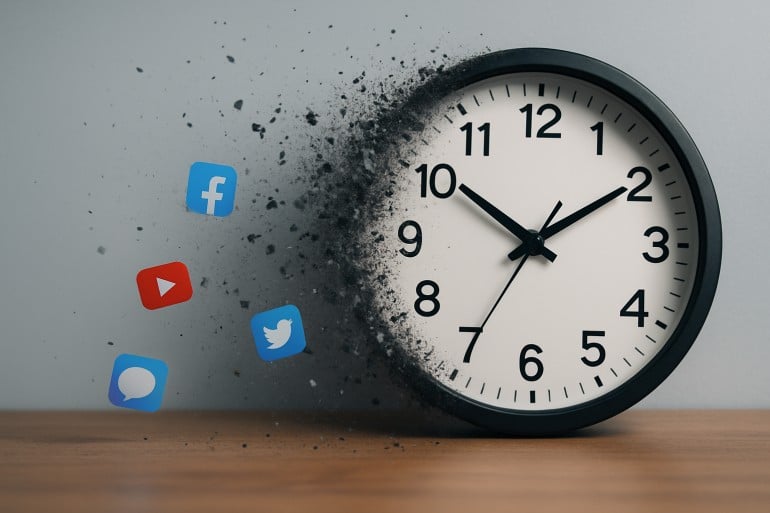
Image by: ChatGPT
Time theft shows up as “just five more minutes” in your inbox, in your browser tabs, and in the spaces between planned tasks.
For independent professionals, it’s elusive because it often looks like work. You’re busy. You’re at your desk. You’re getting things done. But not everything that takes time is time well spent for your business.
Here are some of the most common (and costly) sources of unintentional time theft for freelancers and solopreneurs:
1. Unbilled Admin Work
Proposals, onboarding emails, invoice follow-ups, client handovers, these are all essential parts of running a business, but can fall through the cracks and quietly consume billable hours.
The result? A growing pile of invisible labor that drains your schedule without showing up in your revenue.
One way to bring this into focus is to start categorizing admin tasks separately in an automatic time tracker like Timing. Once you see the actual hours spent, you can make more informed decisions, such as reassessing your workflows or exploring outsourcing tasks that are draining your time. You can also mark time entries by billing status to ensure administrative work doesn’t accidentally slip into client invoices.
2. Context Switching
At first glance, switching from designing a client presentation to answering a quick email may seem harmless, but each context switch comes with a hidden tax: your brain needs time to recalibrate, refocus, and re-engage with the new task.
According to a study published by Gloria Mark, it takes an average of 23 minutes and 15 seconds for a person to return to their original task after an interruption.
Multiply that by the dozens of pivots you make throughout the day, and the impact on your capacity to produce meaningful work and log billable hours becomes significant.
3. Productive Avoidance
Procrastination comes in many forms. Sometimes it’s doomscrolling on TikTok, and other times it’s color-coding a project board or doing more research than necessary.
Sure, these tasks may feel purposeful, but there comes a point where they become a substitute for actual execution—an excuse to avoid doing the work in a way that feels suspiciously productive.
This is known as productive avoidance: the act of choosing low-risk, high-effort tasks that keep you busy, but aren’t effective and come at the cost of momentum.
4. Overworking and Making Zero Progress
There’s a common myth in freelancing and start-up work culture: long hours equal meaningful progress.
It’s easy to fill 10 hours with calls, edits, emails, and back-and-forth messages. But if you look back on the day, you might realize you met no key deliverables, made zero strategic decisions, and had no clear wins.
Sound familiar? That’s a sign you’re working hard without working effectively. You’re optimizing for busyness and not impact. Over time, the gap fuels frustration, burnout, and the feeling that you’re not getting anywhere.
With the right systems and tools in place, you can start measuring your time by hours worked and by what those hours achieved.
5. Forgotten or Untracked Time
When you’re working for yourself, your scheduled “work hours” operate differently. You might answer a client’s question while waiting in line at the grocery store and forget to bill those 15 minutes.
These small moments are easy to overlook, but are still meaningful to your bottom line. Forgotten hours shrink your effective rate and distort your understanding of how much effort a client or task takes. If you’re not tracking the time, you can’t see its cost or recover its value.
Automatic time tracking tools, such as Timing, capture your entire workday, providing data to identify unbilled hours and determine whether to incorporate them into your pricing, establish better boundaries, or refine your workflows. With billing status tracking, you can mark work as Billable when completed, update it to Billed after invoicing, and finally mark it Paid once payment arrives—ensuring no billable work falls through the cracks and giving you clear visibility into outstanding invoices.
![]()
Practical Tips to Prevent Time Theft
Time theft often flies under the radar because it hides in plain sight, but once you start noticing where your time goes, you can make small, consistent changes to improve your output.
Here are five practical ways to prevent time theft and stay on track without becoming rigid or overwhelmed.
Audit Your Work Habits
A time audit of your work weeks helps you understand what’s going on with your billable and non-billable hours across all your projects, tools, and activities.
It helps you identify where time is leaking, notice patterns in your focus, energy, and efficiency, and enables you to adjust your schedule based on reality, not assumptions.
A good audit asks:
- How much of my time went to billable vs. non-billable work?
- What distracted me more than expected?
- Which hours were my most focused or productive?
- Were there any surprises in how my time was spent?
Answering those questions manually can be difficult, especially if you’re relying on memory or manual time logs.
That’s where Timing shines. With an automatic time tracker, all your data is already there. The only thing you need to do is open the Stats screen at the end of the week, and you’ll see:
- How your time is distributed across projects and weeks, hours or days
- Time spent per app, website, or document
- Total screen time for the week
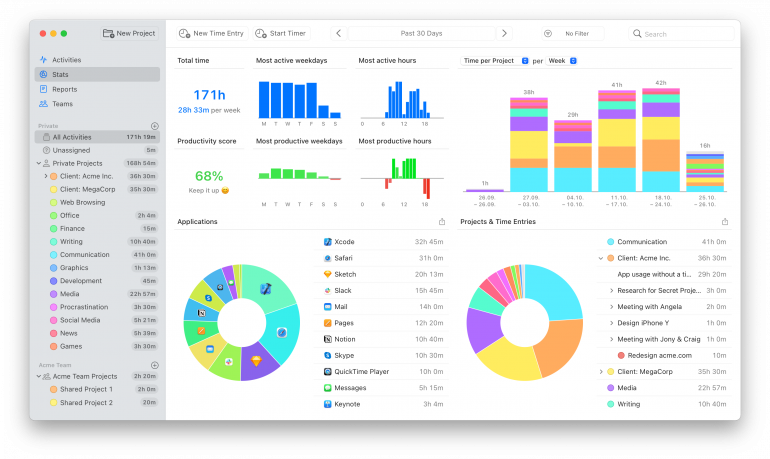
Read More: 2024 Year in Review: Your Blueprint for a Better 2025
Reduce Multitasking with Single-Task Focus Block
Multitasking may feel productive, but it results in fragmented focus and lower productivity. Research shows it can reduce productivity by up to 40% because your brain is constantly switching gears.
Freelancers are prone to toggling between client work, admin, and communication tools throughout the day without realizing how much focus is lost in the process.
One of the simplest fixes is to incorporate single-task focus blocks into your daily routine. Think of it as protected time where you work on one task, distraction-free. Even one or two hours of deep, focused work can improve the quality and speed of your output.
With Timing, you can reinforce the habit. Using the timeline view and the Stats tab, you can gain a clear picture of your focus and how to structure your day better to avoid losing momentum.
Set Project-Specific Goals and Track Progress
As mentioned earlier, scope creep is one of the most common sources of time theft. Without clear time goals for each project, it’s easy to overdeliver, underestimate effort, or lose track of how long “just one more revision” actually takes.
Setting project-specific goals, even rough estimates, gives you a benchmark. You know what “on track” looks like, and when something starts pulling more time than planned.
Timing helps you bring this to life by allowing you to:
- Group work by client or project using rules and smart filters.
- Track time automatically against each one.
- Compare the actual time spent to your original expectations.
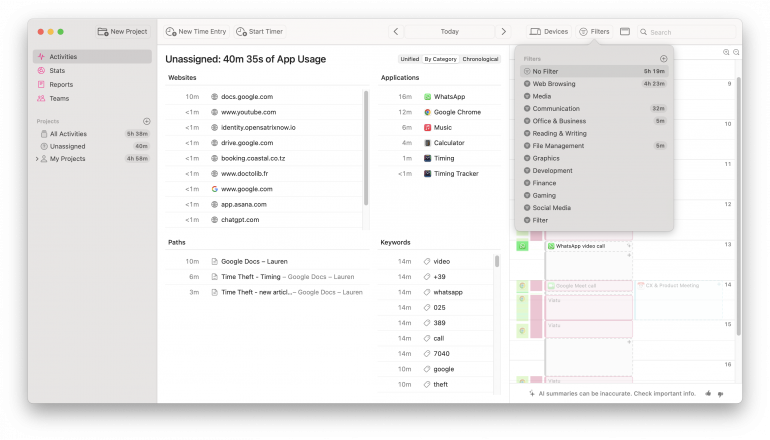
This visibility enables you to make more informed business decisions, whether that involves adjusting your pricing or establishing stronger boundaries with clients.
Identify “Time Sink” Apps and Build Better Habits
Not all distractions come from outside. Sometimes, it comes from your workflow in the form of apps you rely on but overuse.
Tools like Slack, email, or your browser consume hours, especially when used reactively. It’s easy to check a message and end up losing 20 minutes to context switching or unnecessary multitasking.
Timing makes these time-sink patterns visible by showing you exactly how much time you spend in each app. It empowers you to spot digital habits that don’t serve your focus (or goals) and take steps to change them.
You might decide to:
- Batch your email communication into a set time window.
- Mute notifications and block off the time in your calendar for deep work.
- Limit open browser tabs or use site blockers.
Create a Weekly Routine for Reviewing and Adjusting
Preventing time theft isn’t a one-time fix; it’s an ongoing process of reflection and adjustment. That’s why a simple weekly review can be one of the most powerful habits you build.
Set aside 15–30 minutes at the end or beginning of your week to ask:
- Where did my time go?
- Did I hit my project goals?
- What felt productive and what didn’t?
- What changes can I make moving forward?
With an automatic time tracker like Timing, your review is fast and grounded in real data. You can open the Reports tab and your Activities timeline to spot trends, surface inefficiencies, and assess how closely your week aligned with your priorities.
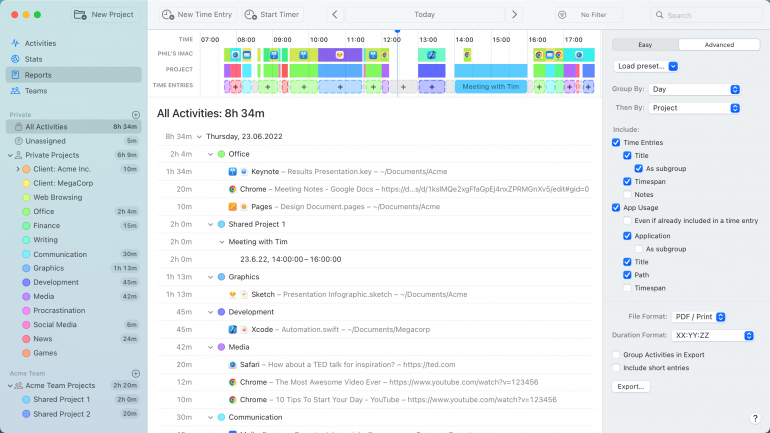
For more tools to streamline your workflow and save more time, check out our curated list of favorite Mac apps: Best Mac Apps: 50+ Essential Tools We Use and Recommend.
How Timing Gives You a Healthy Alternative to Track Your Time
The biggest barrier to solving time theft? Most tracking systems are either too invasive or too much work.
It’s too easy to forget start and stop timers, manual logs are prone to human error, and surveillance-style tools erode trust in teams without delivering real insight.
For solo workers and small teams, the solution isn’t stricter rules or heavy-handed tracking. It’s tools that help you understand your patterns, without judgment, and surface insights you can act on.
Here’s how Timing can help:
Privacy-First Automatic Time Tracking
Manual time logging sounds simple in theory, but in practice, it’s prone to error and often falls apart during the busiest parts of your day.
It’s all too easy to forget to start or stop a timer, which defeats its purpose and gives you inaccurate data for strategic business decisions.
An automatic timer like Timing takes a different approach. It automatically tracks which apps, documents, and websites you use, quietly running in the background while protecting your privacy.
Your data is never shared with anyone. We never take screenshots, store your data online, or sell it to third parties. Your tracked times are always stored locally and never leave your Mac (unless you opt to sync), giving you complete control.
Designed for Self-Accountability in Teams and Individuals
Whether you’re a freelancer, solopreneur, or part of a small team, Timing is built with your workflow in mind.
Each person in a team only sees their data, championing self-accountability and creating a more sustainable and respectful workplace culture. There’s no top-down surveillance of every keystroke, only insights to help individuals and teams take ownership of their time.
Once you’ve logged your time for a specific project as part of a team, your team admins will only see aggregate times associated with each project and any public notes. No personal times or private details are ever shared, protecting your privacy and avoiding a culture of invasive employee monitoring.
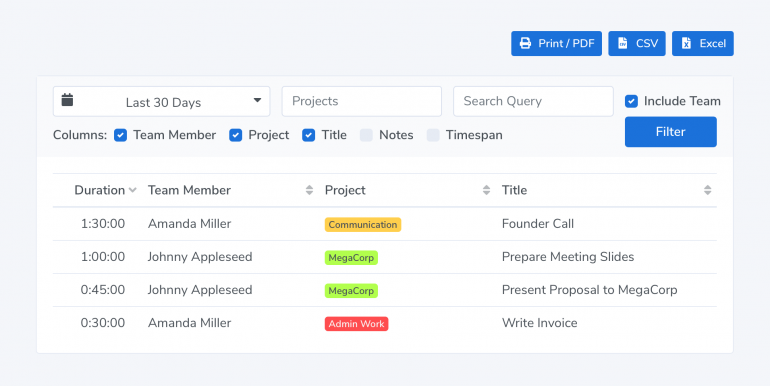
Build Accountability Into Action Through Data-Driven Insights
Timing provides you with more than just raw data; it gives you the tools to make sense of it.
- Use the AI summaries and timeline view to spot gaps, context switching, or distractions.
- Set up smart rules to categorize work by client or project automatically.
Dive into the Stats tab to see where you’re spending your time, when you’re most productive, and identify how much time is billable vs. lost.
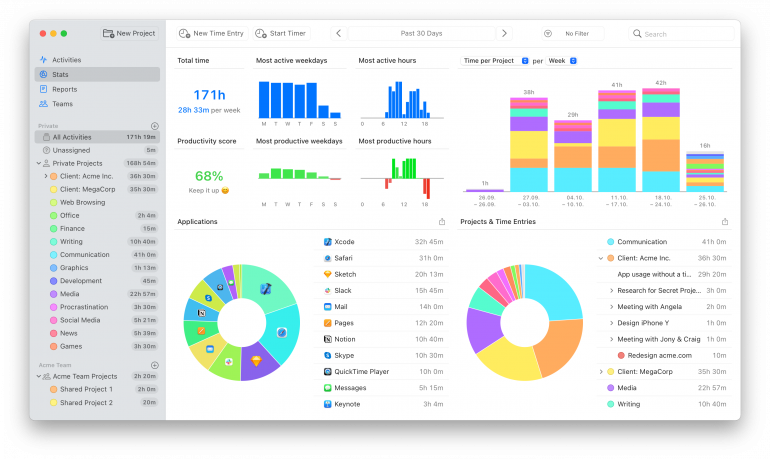
By adding context to your data, Timing empowers you to catch time theft early and uncover patterns without guilt, protecting your deep work and better aligning your time with your goals.
The ROI of Getting Your Time Back

Image by: ChatGPT
As a freelancer, solopreneur, or small team, time is your most valuable resource and your most easily lost. It affects your income, energy, momentum, and the freedom to step away from your business when you need it.
The ability to reclaim even small pockets of time is significant. Let’s say you recover just 30 minutes a day. That’s 2.5 hours every week. Over a year, that’s more than 120 hours and the equivalent of three full workweeks.
Time you could spend earning, creating, building, or resting, guilt-free.
But to get there, you need better awareness. Automatic time tracking tools, like Timing, give you the insight you need to see how your hours are honestly spent, so you can take back your most valuable resource one hour at a time.
Ready to stop time theft in your small business? Try Timing for Mac free for 30 days. No timers, no micromanagement, only data that helps you work smarter.
